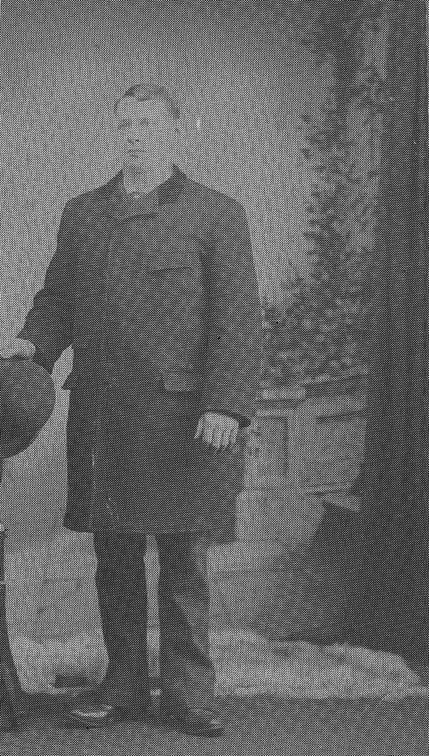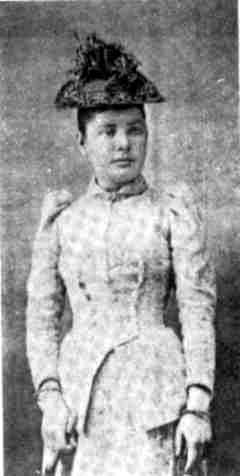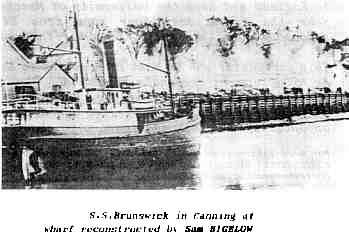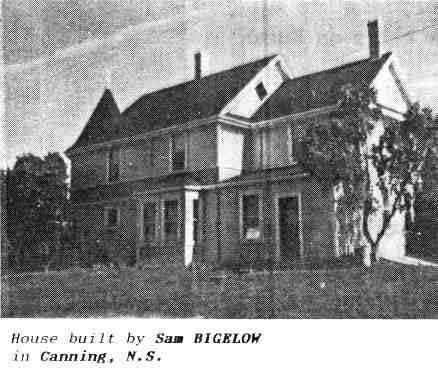Samuel 8 BIGELOW page 2


According to Gideon, Sam, at some point in life, became a Dyke Commissioner.
The "History of Kings County" gives a
thorough account of this title. "Dykes along rivers (originally constructed
by the Acadians) served a double purpose, to keep
out the tides and to be available as roads. The first dykes were made
by the construction of long ridges of sods, sufficiently high
to keep out the tides. The New England planters, however, shut out the
rivers by the construction of aboiteaus. These were
sluice-ways with gates swinging outward at the bottom of the channel,
with a dyke wide enough for a road, built above. After
two or three years of dyking, the salt would be freed from the marsh soil,
and the alluvial deposit was so deep that it would for
many successive years yield two or three tons of hay to the acre, without
fertilization or cultivation of any sort. In the autumn, a
month or two after the hay was gathered, the dyked lands would afford
aftermath for the grazing of cattle and horses. From the
first, the Kings County dykes were built by common labor, and the dyked
lands, while belonging to individuals, were treated in
many respects as a common field. The management of the dykes naturally
led to the creation of special officers known as Dyke
Commissioners, Azzizers, Branders, Dyke Drivers etc. Originally, of course,
the dykes were mown and raked by hand, today
almost all the labour on them is done by machinery."
On June 12, 1894, Sam at age 34 married Catherine
Ann Potter, age 26. Catherine (Cassie) was born October 19, 1868 in nearby
Habitant, N,S., the only surviving child of Capt. Jacob and Laura Potter.
Following is a letter written in pencil by Sam
to Cassie on April 23,1894, two months before their wedding. Notice that
he
refers to himself as a "hayseed".
 Monday Evening April. 23 1894
Monday Evening April. 23 1894 Dear Cassie,
I did not think last night when I was talking with you about the coal mines that I would be so near them to-night. If I only knew some one here that could get a pass for me I would be tempted to stay here tomorrow and go down in the mines but I think it a great chance if I do, this is a great town I tell you, most all small cottages. I expect they are inhabited by miners.
My curiosity is aroused quite a lot over these coal mines and the working of them. I would like to stay here for two or three days to see everything but I know I must be getting along to my destine place and get home. I will tell you about the trip or rather todays travel.
Well to commence I went in to see the baby before dinner and the train blew before I had finished my dinner but eat enough to keep me from starving however got the train all right and reached Kingsport without an accident. Boat left on time. It was just magnificent on the water, not a ripple just right for a Hayseed he would think of being out on a mill pond, some fog but not very thick.
The Hiawatha arrived fifteen minutes after we got in, the first trip of the season, was aboard of the Danacona she is loading with lathes and lumber for Vinyard Haven for orders. Only one regular train out of Parsboro so I came out on a coal train to this place. I can get from here in the morning so that will gain half day. I enjoyed coming out on that train fifty cars on I fell in with a fellow who seemed very sociable so I just asked him all the questions I could think of. A person would think that I had been out for a Month traveling to read this letter. I have been out around town listened to the Salvation Army awhile and came in and went to my room about nine. The next building to the hotel is a hall the band is playing so I had a sheet paper and lead pencil and I thought I would write a line to you. I think more about you than I do about the creamery, you will excuse this letter if it is written with a pencil won't you.
I wish I was near enough to you to get that kiss from your sweet lips, but I know that she has one for me when I return. I want you to think over that suit I mean about the cloth and tell me what you would like for me to get, please and lot of other things, don't be afraid of me I have been thinking all day about what you said last night about making a show. You said if you were up in society it would be a different thing but I think you are well up in it. In my estimation any way, will make a fine woman some day one that will do good I think she is just fine now, don't make fun of me. I am sincere in it all I feel just as though I were talking with you.
So Good Night
With Love From Sam
A report in "Old Timer-Canning and Habitant", (although the date 1919 is incorrect) indicates Sam's expertise.
Wharf repaired 1919- (Sam left Canning 1913)
At one time teams could travel back of the stores. Then it got so narrow that it was only a path. The store owners began to get worried and knew some-thing had to be done. Sir Fredrick BORDEN was home on a short vacation at that time. Three store owners and Mr. Sam BIGELOW, who had quite an insight at wharf building, called on Sir Fredrick. After a few minutes talk he said They'd go down and look at it. He came to the conclusion that something had to be done. The store owners were not financially able to do a job that large, and it would be impossible to move all the stores. The Federal Government of Canada controls the shore lines and wharves. Sir Frederick returned to Parliament Hill and in less than a month a Government man was on the job and an engineer buying timber. Mr. Samuel Bigelow had the abutment completed that fall (no strikes then) with the Government paying the paying the whole shot. The abutment put there in 1919 is still there but showing decay due mostly to the lack of salt water, and tides coming up the river.
Sam foresaw little opportunity for his five sons in Nova Scotia and the lure of the West and homesteading appealed to him. In 1912 he traveled West to inspect the employ- ment situation. In April 1913; Sam, Cassie, the boys and Cassie's mother, Laura Potter left for Saskatchewan. his younger brother Dan, with wife Ellen Spicer and family had moved out previously to take advantage of land made available for settlement. Sam put all his belongings on the train at Canning, together with a man to care for the farm animals. Much of that furniture is in the family's possession today.
The following information comes from Gideon Bigelow. They travelled to Montreal via the Canadian Pacific Railway then down to Chicago and from Chicago to Winnipeg. From Winnipeg they travelled to Saskatoon via the old Grand Trunk railroad system.
Sam began carpentry in Saskatoon and it would appear he built three houses that first year. In 1914 he built a house for his family at 706 Albert Avenue. Oscar was only six at this time. Horace and Ted attended Albert School and Gideon and Potter attended Saskatoon Collegiate. His mother-in-law either lived with them or next door at 708 Albert.
 The offer of 160 acres of virgin farmland virtually
for the asking touched a broad chord in all sorts of people. Hundreds of
Londoners, city dwellers to the core, crossed the Atlantic to try life on
the plains, they were joined by Polish miners, Swedish loggers and Norwegian
fishermen. Eastern Canadians left shops and factories, and Americans poured
across the border to take advantage of Canadian generosity.
The offer of 160 acres of virgin farmland virtually
for the asking touched a broad chord in all sorts of people. Hundreds of
Londoners, city dwellers to the core, crossed the Atlantic to try life on
the plains, they were joined by Polish miners, Swedish loggers and Norwegian
fishermen. Eastern Canadians left shops and factories, and Americans poured
across the border to take advantage of Canadian generosity.
Western Canada became a promised land as well for
religious dissidents of every sort. Hutterites and Mormons from the United
States, Mennonites from Russia, Jewish survivors of the Czarist regime. The
result was a wave of newcomers who did not consider themselves constituents
of a "melting pot" as in the United States, but part of what was called a
new "mosaic of people." By 1911, the population of Canada's West had soared
from a few thousand to more than a million. The pioneer era was over. It
was time for these individualistic people to turn the prairie’s oceans of
grass into fields of grain and make Canada a breadbasket of the world.
In the summer of 1915 Sam along with his son Gideon and Sam's brother Dan and son Edgar drove out from Saskatoon to the homestead with Dan's team of horses. Sam was quite ill on this trip. They had with them a tent and necessary camping equipment. It took a week to make the trip of just over 200 miles. One evening they pitched their tent on the main street of Tisdale. The next day they stopped at Barber's Store in Runciman about 13 miles north of Tisdale to buy supplies such as a wash tub. From Runciman they travelled east to New Osgood then north to a mile west of Zenon Park and then into Arborfield and from there north to the homestead.
When they first arrived they stayed in a cabin belonging to Fred Swanson, a railroad engineer from Wisconsin and an avid sportsman. From here they proceeded to work and establish their homestead on NE Sec 6, TP 49, RG 11.
In letters from Sam to Cassie in Saskatoon, three weeks before he died, Sam tells of his illness and their lifestyle during that summer. In a letter dated Aug. 13th 1915, he tells of his suffering, and that he and Dan were trying to borrow a mower to harvest the grass, but since he couldn't, Dan decided to go to town and buy a new one. They looked over different quarters of land and decided to cancel the boy's two and take up two nearer Sam's which would only be one and a half miles away.
In an Aug 20th 1915 letter to Cassie, Sam tells her that mail only goes out and in once a week. The nearest post office is 3 miles and the nearest store is five miles. A neighbor was going to `Leiberty', 40 miles east, and Sam got him to send back by mail driver, some bovril, grape juice, and aspirin. Dan brought him out a bottle of Fellows compound, a bottle of Rexall for Rheumatism of the stomach and Fruitatives. He tried them all but no good results. Though Dan bought a mowing machine in Tisdale, they had to borrow a rake which took a lot of time as there being no roads, they had to take them to pieces to take them from one homestead to the other. Sam bought 12 hens and a rooster, as eggs were about the only thing he could keep on his stomach, but the hens weren't laying too well, only 4 eggs the first week, but they improved to 4 a day.
Evidently the homestead had some buildings on it as Sam, in his letter, says that when they got there, they found the barn burned and the roof and floor taken off the shack, only the walls left, so they stayed at Mr. Swanson's shack. Sam didn't know if Dan would fix up the shack or build a new one. There was some lumber for sale a half mile away, but Sam didn't feel up to doing the work, yet there was so much to do to prepare for winter and the following year.
Dan was having to do most of the work and running too. He was taking Sam to Arborfield the next day (Sat the 21st of Aug) to see a French Doctor.
Wed. 25th of Aug 1915, Sam tells Cassie that he went to see the doctor on Sunday the 22nd, and the doctor didn't think it cancer yet, but that he was getting discouraged. The doctor gave him different kinds of medication which as he says "takes all my time taking, and I'm a regular drug store, but no better as yet."
Dan put up over 5 tons of hay on Tuesday, and hauled lumber Wednesday to build a shack, and what was left of the log house will make into a barn for the horses.
Some time in early Sept. Dan took Sam to Tisdale where he was put on the train to Prince Albert, then on to Saskatoon. Sam had not wanted Gideon to go with him. In a letter from Cassie to Carrie Coalfleet, Sam's sister, in Nova Scotia, dated Sept 16th 1916, she describes Sam's illness.
"While Sam sleeps I will endeavor to write a few lines. I have not written for some time but others of the family told me they were writing and that has kept you informed as to Sam's condition. You know better than I what cancer means but he is going much quicker than I expected. Day before yesterday he had another hemorrhage, not a bad one I should not think so far, as bleeding is concerned unless it is recurring in his bowels. He vomited about a pint of blood and mucus. Yesterday I only gave him one injection but his relatives were natural. He objects now to injection and food through the bowels it tires him I think.
He does not fear to go. I sometimes think sickness is a blessing as it breaks the tie that binds to earth. When the vein broke Tues. he suffered very much and our medicine for pain was just out and I had sent Horace to have it refilled. It usually happens some such way as to leave one in a hard place. He had only needed his pain medicine once in 7 hours and as it had only been a few hours, was not anticipating anything serious. Now I keep two bottles on hand.
Uncle John's visit has been a comfort but he is going to Alberta today to prepare for house but is expecting to stay here a week on their return. I received Minnie's letter and was very pleased to hear from her but there is no doubt in the minds of any person of experience as to his trouble. Dr. Will Bigelow came from Brandon Sun. to see him but agreed with doctors here."
Sam died of Stomach cancer Sept. 19th, 1915 at age 54. He is buried at Woodlawn Cemetery in Saskatoon. Also, buried in the same plot is Catherine (Cassie) who died Sept. 14th 1949 at age 80; and his mother-in-law, Laura Jane POTTER who died on Aug. 16th 1934 at age 89.
Cassie, with her mother and family stayed in Saskatoon that winter and in the summer of 1916 they all moved to the homestead to a home built by Dan. He and Ellen lived across from the homesite until the forties then moved to Saskatoon.
The transition had been made. From four generations of Maritimers in the small town of Canning, Nova Scotia, Sam and Catherine Bigelow had moved five Bigelow boys to start a new life in the frontier of northern Saskatchewan.
Potter became a school teacher, Gideon a farmer and hardware merchant, Horace a medical doctor, Ted a farmer and mechanic, and Oscar a farmer and sawmill owner.

